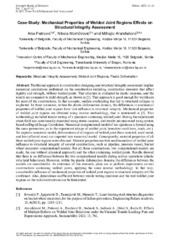Приказ основних података о документу
Case-Study: Mechanical Properties of Welded Joint Regions Effects on Structural Integrity Assessment
| dc.creator | Petrović, Ana | |
| dc.creator | Momčilović, Nikola | |
| dc.creator | Aranđelović, Mihajlo | |
| dc.date.accessioned | 2023-11-28T13:30:49Z | |
| dc.date.available | 2023-11-28T13:30:49Z | |
| dc.date.issued | 2023 | |
| dc.identifier.uri | https://machinery.mas.bg.ac.rs/handle/123456789/7287 | |
| dc.description.abstract | Traditional approach in construction designing and structural integrity assessment implies numerical calculations performed on the construction including construction elements that affect rigidity and strength, without welded joints. That structure is evaluated in elastic response, and the results are compared to yield strength, as shown in [1]. That approach is good enough for workloads for most of the constructions. In that scenario, sudden overloading that led to structural collapse is neglected. In those scenarios, within the plastic deformation domain, the differences in mechanical properties of welded joint regions have vast influence to structural integrity. Mechanical properties of welded joint regions are obtained using inverse methodology, that is mentioned in [2]. That methodology included tensile testing of a specimen containing welded joint. During the experiment strain field was continuously measured using stereo cameras, and results are processed using system based on Digital Image Correlation. Numerical computational model of test specimen is formed using the same parameters, as in the experiment (shape of welded joint, boundary conditions, loads, etc.). To improve numerical model, deformations of all regions of welded joint (base material, weld metal, and heat affected zone) are imported into numerical model. Consequently, material properties of all three welded joint regions were obtained. Material properties are then used in analysis of welded joint influence to structural integrity of several constructions, such as pipeline, pressure vessel, bucket wheel excavator computational models. For all those constructions, two computational models are made, the one without (classical approach) and the other containing welded joints. Results showed that there is no difference between the two computational models during service operations (elastic structural behaviour). However, within the plastic deformation domain, the differences between the models are considerable. As extension of this research, plans are to perform experiments on real constructions containing welded joints, applying the same inverse methodology. In that way, considerable influence of mechanical properties of welded joint regions to structural integrity will be confirmed. Also, dependence coefficient between tensile testing specimen and the real welded joint regions on the real constructions can be formulated | sr |
| dc.language.iso | en | sr |
| dc.rights | openAccess | sr |
| dc.rights.uri | https://creativecommons.org/licenses/by/4.0/ | |
| dc.source | ISCAME - 9th International Scientific Conference on Advances in Mechanical Engineering | sr |
| dc.title | Case-Study: Mechanical Properties of Welded Joint Regions Effects on Structural Integrity Assessment | sr |
| dc.type | conferenceObject | sr |
| dc.rights.license | BY | sr |
| dc.citation.spage | 87 | |
| dc.identifier.fulltext | http://machinery.mas.bg.ac.rs/bitstream/id/18339/978-3-0364-1445-4_87.pdf | |
| dc.identifier.rcub | https://hdl.handle.net/21.15107/rcub_machinery_7287 | |
| dc.type.version | publishedVersion | sr |


